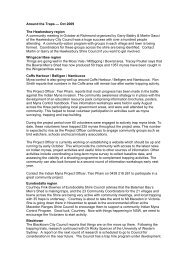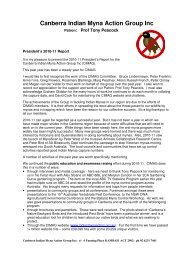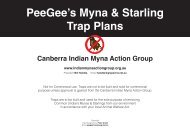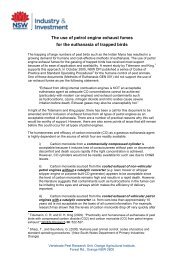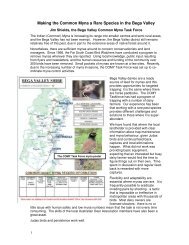Bulletin #22, 28 September 2011 - Canberra Indian Myna Action ...
Bulletin #22, 28 September 2011 - Canberra Indian Myna Action ...
Bulletin #22, 28 September 2011 - Canberra Indian Myna Action ...
You also want an ePaper? Increase the reach of your titles
YUMPU automatically turns print PDFs into web optimized ePapers that Google loves.
<strong>Canberra</strong> <strong>Indian</strong> <strong>Myna</strong> <strong>Action</strong> Group IncPatron: Professor Tony Peacock<strong>Myna</strong> Matters <strong>Bulletin</strong> # 22 (Spring <strong>2011</strong>)Dear CIMAG Members and FriendsThe following provides an update on CIMAG activities:Our 2010-11 AGM and Public Info Night on again – keep 18th Oct freeThat’s right, our AGM and associated Public Information Night is scheduled for 18 th Oct at theSouthern Cross Club, Macquarie – next door to the Jamison Centre. We will start at 7:30 pm.It will be a great night again, with entertaining and informative speakers, prizes awarded andmembers talking about what works / what doesn’t. This year’s entertaining speakers includePeter West. Yes, he of <strong>Myna</strong>Scan fame. You might recall that Peter developed <strong>Myna</strong>Scan asan interactive web-based mapping and recording “thing”. It is really neat. Don’t miss out onhearing all about it and how you and CIMAG can use it. We encourage all our members to logonto the <strong>Myna</strong>Scan website: go to http://www.feralscan.org.au/mynascan/ and start playing. TheCommittee reckons it will provide enormous benefits to our myna-reduction campaign, but weneed CIMAG members to log on and enter their data. Peter will tell how to do that. KateGrarock has now completed all the data collection for her PhD research project on mynas andwill speak to us about what she has discovered. Can’t wait to hear that. And of course ourPatron, Prof Tony Peacock will talk to us – but this time via the ether as he will be in Melbourne.Come along and join other members and anti-myna friends in a fun night.CIMAG praised in the federal ParliamentThe cause of <strong>Indian</strong> <strong>Myna</strong> control got a real boost the other day whenCIMAG and our efforts were raised in federal Parliament. Gai BrodtmannMP, the Member for <strong>Canberra</strong>, spoke about the results that we have hadthrough our community-action program in reducing myna numbers in thisregion. You can read Ms Brodtmann’s wise words in the Communitysection of www.gaibrodtmann.com.au/speeches/ . As a consequence Ihave already had people from Parliament get in touch to find out how theycan do things in their electorates. Thanks for the mention, Ms Brodtmann.Your contribution is most valuable and will take this important conservationeffort out to many other electorates across eastern Australia.Ms Brodtmann speakingabout mynas in ParliamentTrap building by Yurung Dhaura teamWe have been fortunate that a members of the YurungDhaura (meaning Strong Earth) team of indigenousnatural resource management trainees have beenbuilding traps for us – when the weather doesn’t allowthem to do outside work. Krystal Hurst, Adam Shipp,Jake Lester and Greg Chatfield have churned out somereally high quality traps. Thanks very much Krystal,Adam, Jake and Greg, and thank you to Joe Stephens,their supervisor, and Anna van Dugteren of the ACTEnvironment and Sustainable Development Directorate,Krystal Hurst, Jake Lester & Adam Shipp gettingstuck into making traps for CIMAGfor their support in getting this going. This is a good project for the team and for CIMAG: theteam gets to participate in another side of natural resource management and CIMAG gets somereally good traps. We can only hope that <strong>Canberra</strong> gets lots of rain in the near future!!<strong>Canberra</strong> <strong>Indian</strong> <strong>Myna</strong> <strong>Action</strong> Group Inc: president@indianmynaaction.org.au: ph 02 6231 7461 1
<strong>Canberra</strong> <strong>Indian</strong> <strong>Myna</strong> <strong>Action</strong> Group IncPatron: Professor Tony PeacockThe CIMAG Committee – a few changesWe have lost Peter Franklin to warmer, albeit wetter climes: Newcastle – Peter reports the mynacontrol task up there is enormous. We thank Peter for his work as Secretary of CIMAG for thelast number of years and for all his work on trap building, nest box making, and especially forsweeping out my garage after trap-building sessions. Megan van der Velde has taken overPeter’s role as our Secretary. Apart from the Committee, we would like to get some people tohelp out on particular tasks: we would especially like 3 volunteers to be “whipper-snuffers” innorth, south and west <strong>Canberra</strong> once we have nesting box traps erected. More of that at theAGM night.<strong>Myna</strong>s versus Miners — a silly argument and most unhelpful to sensible conservationIn recent times there has been a line of argument, even in some Australian scientific papers,that the native Noisy Miner is worse than the introduced <strong>Indian</strong> <strong>Myna</strong>s in terms of impacts onother native birds and their habitats. The comparison is silly, arising in part to the similarity ofnames. There has even been some criticism of CIMAG and other community-action groups thatwe are focusing on the wrong villain!Bruce Lindenmayer, our Vice President and prominent local ornithologist, puts the position in amore sensible light. Bruce does note that Noisy Miners – native honeyeaters – have moved intourban areas alongthe east coast, andthat studies haveshown that theiraggression aroundfood sources doespush out otherhoneyeaters andsmaller birds from<strong>Myna</strong>s vs Miners:some areas. To date,a silly argumentNoisy Miners havenot become commonin <strong>Canberra</strong> norreported as aparticular problem in<strong>Canberra</strong> gardens:our backyard native bird bullies are Currawongs and Wattlebirds.Bruce states that Noisy Miners, unlike the introduced <strong>Indian</strong> <strong>Myna</strong>s, do not exclude native birdsfrom nesting hollows nor are they a serious pest nesting and roosting in suburbs and ceilings,and fouling backyard patios. Accordingly, they do not stop native birds from using tree hollowsto breed in: this is one of the very serious concerns with <strong>Indian</strong> <strong>Myna</strong>s. This seems to be thecritical aspect that is overlooked by those that regard mynas as benign.The myna / miner issues are different, and it is pointless to link them! Rather, the focus shouldbe on addressing all ecologically threatening processes no matter if they arise from non-nativeor native species, or from human activity. CIMAG and other community/local government actionprograms are doing their part on one of the big ones: the ecological threat posed by mynas.Animal Welfare IssuesSince we started in 2006, CIMAG has stressed the need for humane treatment, painlesseuthanasia and appropriate disposal of trapped mynas.We use a trap which minimises stress – it has a roost, food, water and a shadecloth cover overthe holding chamber. Additionally, CIMAG has developed an animal welfare protocol (which allmembers sign on joining), and have an on-going relationship with the RSPCA, the ACTGovernment, the ANU and other conservation groups. And we follow Chris Tidemann’sresearch which shows that carbon monoxide is preferable for euthanasia.Over recent decades, public attitudes to animal welfare have changed markedly. Cruel orcareless practices, once accepted or overlooked, are now no longer seen as appropriate by thecommunity. CIMAG wishes to stay free from any dodgy practices. It would take only one or tworeports of careless behaviour to damage our good reputation and set back our programs.<strong>Canberra</strong> <strong>Indian</strong> <strong>Myna</strong> <strong>Action</strong> Group Inc: president@indianmynaaction.org.au: ph 02 6231 7461 2
Form 990 2009) MANHATTAN CHRISTIAN COLLEGE FOUNDATION 48-1055555 Pa ge 3Part IV Checklist of Required Schedules1 Is the organization described in section 501 (c)(3) or 4947(a)(1) (other than a private foundation)?If "Yes," complete Schedule A2 Is the organization required to complete Schedule B, Schedule of Contributors? X3 Did the organization engage in direct or indirect political campaign activities on behalf of or in opposition to candidates forpublic office? If "Yes," complete Schedule C, Part 1 3 X4 Section 501 ( c)(3) organizations . Did the organization engage in lobbying activities? If "Yes," complete Schedule C, Part 11 4 X5 Section 501 (c)(4), 501( c)(5), and 501 ( c)(6) organizations . Is the organization subject to the section 6033(e) notice andreporting requirement and proxy tax? If "Yes," complete Schedule C, Part 111 56 Did the organization maintain any donor advised funds or any similar funds or accounts where donors have the right toprovide advice on the distribution or investment of amounts in such funds or accounts? If "Yes," complete Schedule D, Part 1 6 X7 Did the organization receive or hold a conservation easement, including easements to preserve open space,the environment, historic land areas, or historic structures? If 'Yes," complete Schedule D, Part ll . . - 7 X8 Did the organization maintain collections of works of art, historical treasures, or other similar assets? If "Yes, " completeSchedule D, Part Ill 8 X9 Did the organization report an amount in Part X, line 21; serve as a custodian for amounts not listed in Part X, or providecredit counseling, debt management, credit repair, or debt negotiation services? If "Yes," complete Schedule D, Part IV 9 X10 Did the organization, directly or through a related organization, hold assets in term, permanent, or quasi-endowments?If "Yes," complete Schedule D, Part V - - 10 X11 Is the organization's answer to any of the following questions "Yes"? If so, complete Schedule D, Parts Vl, Vll, VIII, IX, or Xas applicable - 11 X• Did the organization report an amount for land, buildings, and equipment in Part X, line 10? If "Yes," complete Schedule D,Part VI• Did the organization report an amount for investments - other securities in Part X, line 12 that is 5% or more of its totalassets reported in Part X, line 16? If "Yes, " complete Schedule D, Part VII.• Did the organization report an amount for investments - program related in Part X, line 13 that is 5% or more of its totalassets reported in Part X, line 16? If "Yes," complete Schedule D, Part VIII• Did the organization report an amount for other assets in Part X, line 15 that is 5% or more of its total assets reported inPart X, line 16? If 'Yes,' complete Schedule D, Part IX.• Did the organization report an amount for other liabilities in Part X, line 25? If "Yes, " complete Schedule D, Part X• Did the organization's separate or consolidated financial statements for the tax year include a footnote that addressesthe organization's liability for uncertain tax positions under FIN 48? If 'Yes," complete Schedule D, Part X.12 Did the organization obtain separate, independent audited financial statements for the tax year? If "Yes," completeSchedule D, Parts XI, XII, and XIII. 12 X12A Was the organization included in consolidated, independent audited financial statements for the tax year? Yes NoIf "Yes," completing Schedule D, Parts Xl, XIl, and XIII is optional 12A X13 Is the organization a school described in section 170(b)(1)(A)(ii)? If "Yes," complete Schedule E -- - 13 X14a Did the organization maintain an office, employees, or agents outside of the United States? 14a Xb Did the organization have aggregate revenues or expenses of more than $10,000 from grantmaking, fundraising, business,and program service activities outside the United States? If "Yes," complete Schedule F, Part I15 Did the organization report on Part IX, column (A), line 3, more than $5,000 of grants or assistan ce to any organizationor entity located outside the United States? If "Yes," complete Schedule F, Part II - - -16 Did the organization report on Part IX, column (A), line 3, more than $5,000 of aggregate grants or assistance to individualslocated outside the United States? If "Yes," complete Schedule F, Part III17 Did the organization report a total of more than $15,000 of expenses for professional fundraising services on Part IX,column (A), lines 6 and 11 e? If "Yes,' complete Schedule G, Part I - -18 Did the organization report more than $15,000 total of fundraising event gross income and contributions on Part VIII, lines1 c and 8a? If 'Yes,' complete Schedule G, Part Il -19 Did the organization report more than $15,000 of gross income from gaming activities on Part VIII, line 9a? If "Yes,'complete Schedule G, Part III - -Form 990 (2009)93200302-04-10
<strong>Canberra</strong> <strong>Indian</strong> <strong>Myna</strong> <strong>Action</strong> Group IncPatron: Professor Tony PeacockAround the TrapsSome really great developments are happening on the myna-control front elsewhere inAustralia. Read on about the efforts of other groups. The “Happenings Elsewhere” section ofthe CIMAG website (www.indianmynaaction.org.au) has more on this.The Clarence Valley Conservation in <strong>Action</strong> group in northern NSW is working up a good myna controlprogram involving the local Juvenile Justice Centre, Envite and a volunteer from Volunteering ClarenceValley in trap building. They have recently started stalls at local markets as a way of getting theirmessage out to the community. They passed their 1,000 trapped myna back in July and have a smalldedicated group on the case up there under the co-ordination of Laura Noble. See their website(www.cvcia.org.au ) for more info.Tweed and Byron Shire Council’s myna control program is now well established with well structured,well managed and very effective activities: over 4,500 mynas have been removed since the programstarted. The myna control program looks to expand its approach to conservation management up therewith funding for a broader program of activities that will tackle mynas, cane toads, rabbits, foxes etc. PamGray, the Project Leader, says the aim is to support the restoration and rehabilitation of urban and periurban bushland.in the district. Hopefully the new funding comes through for that.Paul Formosa of the Wollongong <strong>Indian</strong> <strong>Myna</strong> <strong>Action</strong> Program indicates that the program continues toattract new participants. They now have a total of 330 registrations since they began earlier this year.This is absolutely marvelous and shows how the community has gotten right behind the program. Lastweekend they ran their 16th workshop at which they provided information about the programs objectives.The Corrimal Community Men's Shed continue to supply traps: they have developed a round versionwhich has proven to be sturdy and quicker to make. See a photo of the round “Corrimal Trap” and otherinfo on our website.Byron Kearns, the Land Protection Officer on the Townsville City Council mentions that their program oferadicating mynas from Magnetic Island is now complete: the last two crafty ones were done away withby Byron’s even craftier plan. It is wonderful news to know that the island is now myna-free. The councilis now undertaking a program to educate the folk on the island in identifying and eradicating mynas ifthey return. Now Byron has turned his attention to the really big task: to rid Townsville itself of the pests.The Royal Botanic Gardens in Cranbourne Victoria continues with its program of myna control withsome very positive and encouraging results. David Hunt reports that they have solved their problems withnative mammals raiding the PeeGees trap by putting the trap within a floppy top enclosure. The catchsince they introduced the PeeGees trap in May last year is 200 but more importantly they have donesome analysis on native bird numbers around the depot where they are trapping. While still at an earlystage, and the cause cannot be totally certain, myna numbers observed during their weekly transectcount have dropped (from 31 per week to 20 per week) and indigenous species richness hascorrespondingly increased: 25 per week to 35 per week – some 40 native species were observed in the12 months before trapping and 49 native species have been observed in the 12 months since. They areall great signs that there is something very good happening down there. If you haven’t been to theRoyal Botanic Gardens in Cranbourne, put it on your “must-do” list for next time you are in Victoria. Atruly wonderful spot.Hawkesbury <strong>Indian</strong> <strong>Myna</strong> <strong>Action</strong> Group (HIMAG) powers on. It looks like they have beaten us togetting the flat pack made up by their correctional services inmates. Our prototype still languishes in theAlexander Maconochie Centre awaiting mass production. In addition, the local Hawkesbury Men’s Shedhas now made over 140 PeeGee traps, and it is gratifying to hear the feedback on its effectiveness. Oneof the HIMAG coordinators for Pitt Town, Peter Ryan, mentions that they have worked out an approach toentice the smarter mynas into the trap – by putting a little peanut butter on the dog food. Don’t needmuch, apparently. They also find that it is important to keep the trap washed down between trappings.Tracey Poulter from Wingecarribee Shire Council says that their capture results are now up to 2195<strong>Indian</strong> <strong>Myna</strong>s and 108 European Starlings. So, good work up there. She has been contacted by peopleoutside their shire for information, so let’s hope that something comes from that. There was also plenty of<strong>Canberra</strong> <strong>Indian</strong> <strong>Myna</strong> <strong>Action</strong> Group Inc: president@indianmynaaction.org.au: ph 02 6231 7461 4
<strong>Canberra</strong> <strong>Indian</strong> <strong>Myna</strong> <strong>Action</strong> Group IncPatron: Professor Tony Peacockinterest from Wingecarribee residents in regards to <strong>Indian</strong> <strong>Myna</strong>s and what people can do to control themwhen Council held their Threatened Species Display in one of the local shopping centres. The poster thatthey used gave some prominence to mynas.Andre Pieterse from Johannesburg, South Africa advises that a tree trapping exercise over there hashad some good success. The local authorities erected a tarpaulin over a roosting tree. After a few daysthe birds were all back. Some toxic gas was then placed under the tarpaulin and managed to removeover 100 birds in one night. I am seeking more information from Andre on how this worked. This seemsto be a similar to Chris Tidemann’s roosting tree trap concept which had to be abandoned because ofstructural instability in any sort of breeze.Murrumbateman Landcare Group is getting their traps out as the ripening season for grapesapproaches. They find this is the most effective time of the year as the mynas come in to raid thevineyards: and one which pays big dividends for the vignerons over there. No doubt we will be able todrink their success!Trapping numbers for the last few monthsReasonably good number of trappings over the past few months although again we find thatwary mynas are avoiding traps. Time for us to move to the nesting box trap – but awaiting anew protocol on that before distribution. We have over 150 people waiting for a trap: sadly thegaol has not produced as many this year as last. This is a real shame as when traps go to newareas we always get good capture numbers. The recent reported monthly numbers are:Apr11May11Jun11Jul11Aug11<strong>Myna</strong>s 564 662 430 340 237 for a total of 38,296 mynas to end August <strong>2011</strong>.Starlings 61 36 12 3 13 The attached chart shows trapper numbers, totalcaptures by suburb for six-monthly periods to June11.CIMAG Website and News DistributionSystemThere is a lot of interesting information aboutmynas and about who is doing what to controlthem, on our website. Also it has some goodscientific papers, plans for the trap, brochures andleaflets, and back issues of the <strong>Bulletin</strong>.You are very welcome to use whatever informationon the website that you want.To get onto the CIMAG email distribution systemfor this <strong>Bulletin</strong>, news and notices from the CIMAGCommittee, just send a blank email tonews-subscribe@indianmynaaction.org.auIf you are interested in having someone fromCIMAG talk to your organisation or work groupabout the threats posed by mynas and whatCIMAG and others are doing, just get in touch.Peter West has prepared this map showing thecaptures in <strong>Canberra</strong>’s “cities” since 2006.Bill HandkePresidentCIMAG<strong>28</strong> Sept <strong>2011</strong><strong>Canberra</strong> <strong>Indian</strong> <strong>Myna</strong> <strong>Action</strong> Group Inc: president@indianmynaaction.org.au: ph 02 6231 7461 5



